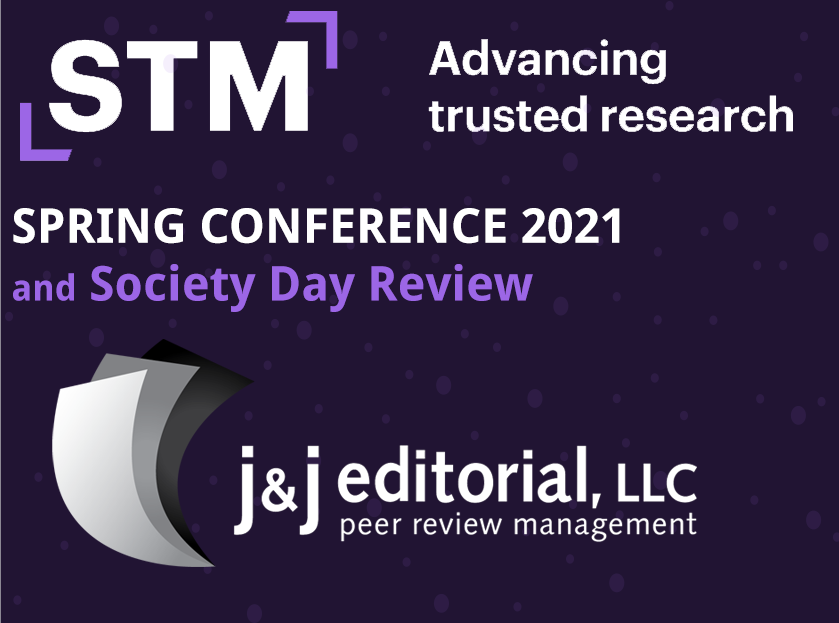STM, or the International Association of Scientific, Technical and Medical Publishers, is somewhat unique among scholarly publishing societies. It is European-based, but it has global reach, with a strong presence in North America and elsewhere. The association focuses its efforts largely on serving the needs of publishing and library decision makers and executives, and as such, the content is often geared towards defining and predicting global publishing trends, initiatives, and technologies. J&J has had a relationship with STM since 2019, when staff attended our first STM meeting in Washington, D.C.
In April 2021, J&J’s Emily Babcock and Michael Casp attended STM’s Virtual US Spring Conference. J&J also sponsored “Society Day,” which was Day 1 of the STM meeting. As the name suggests, Society Day focused on the views and needs of society publishers and other mission-driven organizations. The keynote speaker was the Editor in Chief of the New England Journal of Medicine (NEJM), Eric Rubin, M.D., Ph.D.

Dr. Rubin gave an overview of NEJM’s response to COVID-19, and the challenges they faced. Like many medical journals, NEJM faced an unprecedented spike in submissions while the pandemic made it difficult if not impossible to hire more supporting staff. Because of this, many nights and weekends were devoted to the cause of moving important COVID-19 papers through the peer review and production process. Dr. Rubin touched on the fact that despite the challenges, editors were able to expedite important COVID-19 papers through the publication process while maintaining quality. However, he also pointed out that some papers were of lower quality than NEJM would typically publish because of the time-sensitive nature of the topic. Clinical physicians needed information on this new disease and treatments, and so lower-quality data was published to try and meet that need in a timely fashion.
STM-US Day 1 also featured Rachel Martin from Elsevier and Philippa Grand from Bristol University Press. Both speakers talked about their organizations’ commitment to the United Nations Sustainable Development Goals. The UN SDG Publishers Compact, launched in 2020, was set up to inspire action among publishers to accelerate progress to achieve the Sustainable Development Goals by 2030, asking signatories to develop sustainable practices, act as champions, and publish books and journals that will “inform, develop and inspire action in that direction.”
Later in the day, we heard from several speakers who discussed automation and standards for bringing together data from funders while linking it more effectively to the submissions that were funded. Specifically, these efforts involve developing tools to disambiguate authors and their affiliations and presenting authors with the ability to claim their funder and grant information from within a manuscript submission workflow.
Day 2 of the STM Conference included a session focused on cybersecurity, in which librarians and tech providers discussed challenges in protecting library and institutional networks. Speakers touched on the important collaborations that need to happen between libraries and their tech partners to secure networks and plan for breaches. Because of the number of students and researchers served, libraries can often function as a door for bad actors to access other institutional data on the network. Upgrading security in libraries can help keep their institutions more secure.
Other topics covered on Day 2 included a new European Union Copyright Directive as it relates to article sharing and how COVID-19 has affected funding, university budgets, and researchers’ needs.
Day 3 of the STM Spring Conference, or “Innovations Day,” started with a session focused on trends and where we might see the industry in 2025. Speaker Eefke Smit, STM’s Standards and Technology Director, gave a talk with the theme “go upstream” to the source of content, i.e., to the researcher, and focus on researcher priorities and workflows as the driving force of scholarly publishing innovation in the near future. The presentation used the metaphor of a river to reflect the flow of content and included a creative graphical representation of the publishing industry:

Overall, I found the presentations from the 2021 STM-US Conference engaging because they offered a window into how decision makers are viewing the immediate future of our industry. It was also enlightening to hear about how a prestigious journal struggled through 2020 just like the rest of us. I ended up quite pleased with J&J’s sponsorship of this event and look forward to more from this organization in the future.
Many of the STM-US 2021 sessions are available to view at the following links:
- STM Spring Conference Society Day 2021
- STM Spring Conference Day 2 2021
- STM Spring Conference Innovations Day 2021
This article was contributed by Michael Casp, J&J Editorial’s Director of Business Development.
